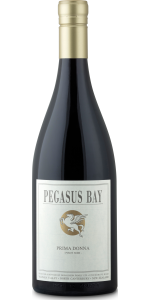
Description
Upon relase the colour is deep ruby. The bouquet is a seductive patchwork of red and dark fruit, with hints of violet, liquorice and a dried herb compexity. But there is more, autumn undergrowth giving way to sweet spice and smokey mineral notes. Fine grained silky tannins and bright acidity dance harmoniously on the palate, balanced by a dense core of ripe fuit. Elegant and haunting, yet powerful, with classic structure and a prolonged satisfying finish. While ready to drink on release it can be expected to cellar well and evolve gracefully for many years.
Awards
97 pts James Suckling
5 stars Michael Cooper’s Buyer’s Guide
Certifications
Alcohol
13.0%
Analytical data
dry
Vineyard
The vineyard is located within the Waipara Valley of North Canterbury, on free draining, north facing terraces. It benefits from being in the lee of the Teviotdale Range, giving maximum protection from the Pacific’s easterly breezes and thus creating a unique mesoclimate. The vines are over 30 years old, with a large proportion planted on their own roots. They are located on the “Glasnevin Gravels” where greywacke stones, silt and loam have been washed down from the mountains over the millennia. The soil is of low fertility, resulting in naturally reduced vine vigour. This produces low yields of optimally ripened, high quality, flavourful grapes, which fully express the qualities of this unique terroir. The vineyard has warm days, but the nights are amongst the coolest in the Waipara Valley, drawing out the ripening period of the grapes, while still retaining good natural acidity.
Vinification
Prima Donna is part of our reserve series which we only make in exceptional years, provided it does not compromise the quality of our estate wines. It is a selection from the best barrels, coming from some of the oldest ungrafted plantings in the vineyard, characterised by small berries and loose open bunches. As with all our Pinot’s, we use traditional Burgundian winemaking methods. Approxinately one third of the grapes were put at the bottom of the fermentation vats as whole bunches, with the balance being destemmed on top, retaining as many whole berries as possible. The vats were kept cool over the next few days to help extract the soft, silky tannins from the pinot noir skins. After approx a week, the must started to ferment naturally. During fermentation the skins of the grapes were gently plunged twice daily. When the fermentation finished, the grape remnants were left to steep in the wine for up to a week to help extract a different range of tannins that add structure and depth. The exact duration of this period was determined by daily tasting. Subsequently the wine was gently pressed off and put into oak barriques (approx 40% new) from selected artisan Burgundian coopers. In the summer after harvest, when the weather warmed, the wine underwent a natural malo-lactic (secondary) fermentation. After maturing for 14 months, a selection from the best barriques was chosen and carefully blended, to produce the most complex and balanced wine possible.
Maturation
14 months


